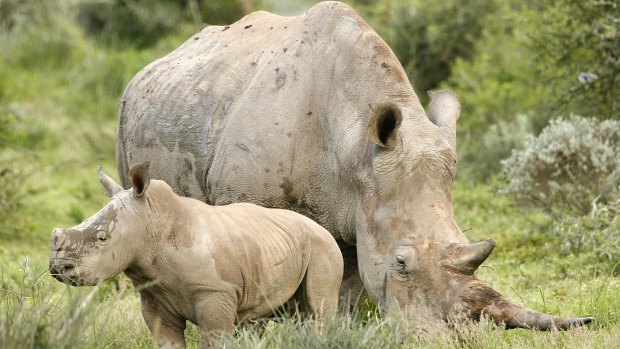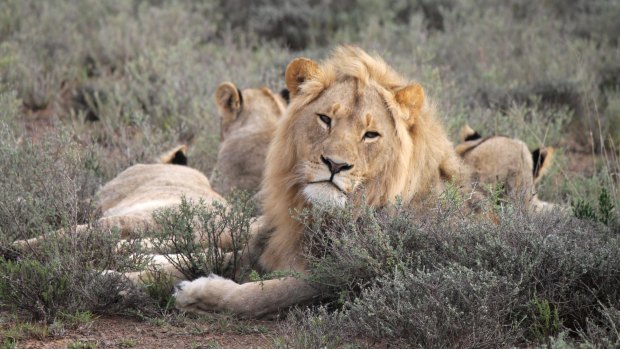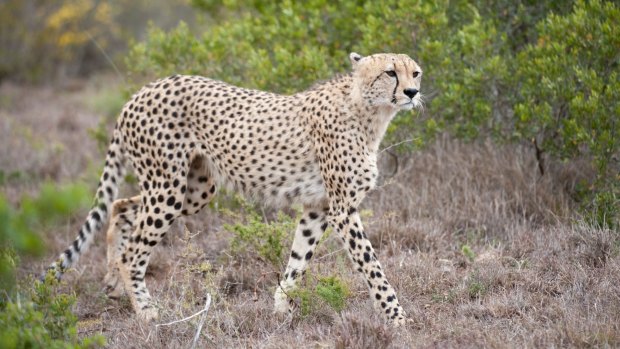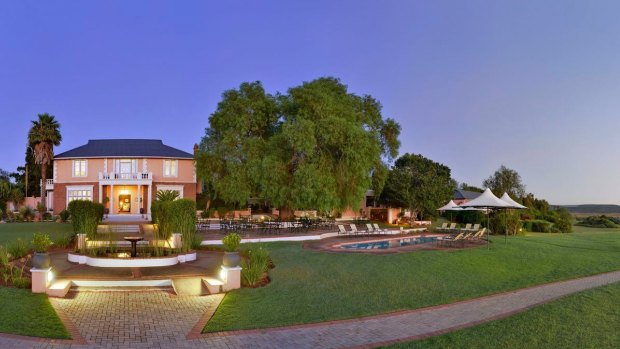This was published 6 years ago
Shamwari Game Reserve, South Africa: The most perfect moment in travel
By Ben Groundwater

White rhino mother and baby at Shamwari Game Reserve. Not the same pair seen by the author, but just as picture perfect.Credit: Alamy
It seems staged, like a lot planning has gone into this moment; into the wrangling of a rhinoceros and its tiny offspring to ensure the pair appear in this exact place at this exact moment, looking calm and natural, right there in front of us. Real life can't be this perfect, you know something tricky must surely be going on behind the scenes.
And yet, it's not. It can't be. There's no trapdoor for these huge animals to appear from; no wall for a troupe of handlers to hide behind. There's no other explanation for this moment of absolute perfection playing out before us but sheer, dumb luck.
It was worth the wait; worth the drive. My girlfriend, Jess, and I arrived in Johannesburg a few days ago, picked up a hire car and spent all of the day driving south through this spectacular country, from the high veld in South Africa's north to the stream-riven farmland of the Eastern Cape. We'd been driving for 10 hours by the time we rolled into Shamwari Game Reserve, past a couple of zebras, near a few warthogs, pulling up at the lodge and checking in.

Lions working hard in South Africa.Credit: Shuttershock
We'd dragged ourselves up the grand old staircase in the main homestead and into our room, grabbed a couple of beers from the fridge and opened them while making our way onto the balcony. We'd taken a seat there to admire the splendour of South Africa, to watch as dusk enfolded the game reserve laid out before us, to rest our limbs and recover, when this … this happened.
It's a lazy travel writer's cliche to profess to be moved to tears by a moment of beauty – is everyone really crying that much? – but Jess is most definitely welling up as we sit there on the balcony and watch as two of Africa's most beautiful and sought-after animals magically appear before us, padding silently across the grassy clearing towards a waterhole where mother and calf stop to drink, gaze around in the slowly dying light, and then amble away again, back into the bush, into the darkness.
It's one of those, "Did that just happen?" moments. I actually ask the Shamwari staff later if they planned it, only half jokingly, though clearly they couldn't have. It's just one of those things that seems to happen around here, the perfect introduction to South Africa, to life on safari, to everything Shamwari has to offer.

A cheetah at the reserve is alert to the presence of a photographer.Credit: Alamy
And that's a lot, despite this not being even close to one of the country's most famous reserves. It's nowhere near Kruger National Park. It could hardly be further from Sabi Sand. Shamwari is a modest – by comparison – patch of former agricultural land near the southern town of Port Elizabeth, a conglomeration of former farms that have been slowly restored to their former glory. The Eastern Cape used to be filled with wildlife, but these days it's pretty much barren once you're outside the Shamwari fenceline. Inside that protective barrier, however, something beautiful has happened, with giraffes, leopards, lions, elephants, oryx, waterbuck, eland, hippos and many, many more species are now thriving in the beautiful hills.
And we're going to see them. After that beer on the balcony, Jess and I join the other guests for dinner, and meet Westley , our wildlife guide, who says he's planning a night game drive. "We've had some good sightings the last few nights," he says in his broad South African accent. "Let's get out and see what we can find, uh?"
We're on the hunt for lions tonight, searching for red eyes glowing in the torchlight. There are two prides at Shamwari, Westley explains, the north pride and the south pride. We're hoping to spot a few from the former, but luck is no longer on our side. We do watch, however, with bated breath , as a hippo out of the water, hauls its huge bulk, with incredible speed, back to the safety of a natural pool.

Long Lee Manor, one of the accommodation options at Shamwari.
Westley seems to know every inch of Shamwari's 25,000 hectares of land. His sense of direction is unerring; his knowledge encyclopedic. Even when there are no animals around he's constantly rattling off titbits of information, identifying shrubs and trees, spotting footprints, describing animal behaviour, predicting our next sighting. Every Shamwari guide, Westley explains, has to walk unaided from one side of the park to the other before they can become qualified, which sounds simple until you consider the size of the park, and the size of the animals that roam free here.
Though Shamwari is primarily a conservation project – there are three education and rehabilitation facilities onsite – part of the area's human history has also been retained. Of the six, separate five-star lodges on the property (some that allow children, some that don't), the first to open, the place where Jess and I perched on the balcony to share a sunset beer and a surprise rhino viewing, is Long Lee Manor, one of the Eastern Cape's original farmhouses, built in 1916.
It's a beautiful old building that commands views across manicured gardens to the savannah. There's something charmingly traditional about the way Long Lee is run, too, with big family-style meals and friendly service. It brings you together with the people with whom you share a safari vehicle, allows you to get to know other people as well as the South African bush. One guest here, we find out, is on her ninth trip to South Africa in nine years. Another is on her first overseas holiday.
Each day here has a familiar rhythm: rise early for a morning game drive, spreading blankets over laps to fight off the cold, before returning to the manor for a full breakfast; rest during the warmest hours, just as the animals do; head out again with Westley in the afternoon, on the hunt for whatever the African bush chooses to reveal; and then toast the sunset with a gin and tonic before sharing a huge dinner and tales of adventures past.
It's not until day three that we finally find those lions. Westley spots a few hartebeest – large antelopes, bolting skittishly through the bushes. "This might be something," he mumbles, pulling the car off the dirt track, pointing its nose at the place where the hartebeest began their sprint. Sure enough, we bump over a few rocks, scrape past a few shrubs, pull up in a clearing, and there they are: the south pride, six lions relaxing in the sun, fixing us with wild eyes, staring at the only humans for miles around.
It's another moment of safari perfection, another event so precise and so moving that it seems like it must surely have been staged. But it can't have been.
Ben Groundwater stayed as a guest of Shamwari Game Reserve
Qantas flies direct from Sydney to Johannesburg six times a week, with onward connections to Port Elizabeth. qantas.com or call 13 13 13. Transfers are available from Port Elizabeth to Shamwari via the lodge.
STAY
Shamwari Game Reserve is a 25,000-hectare private game reserve situated one hour's drive from Port Elizabeth. There are six separate five-star lodges on the reserve, and one tented camp. Rates at Long Lee Manor at Shamwari start from $532 per person per night, inclusive of all meals and guided activities. shamwari.com
MORE THINGS TO DO IN THE EASTERN CAPE
JEFFREYS BAY
One of the world's most famous surf breaks – and yes, the place where Aussie surfer Mick Fanning punched a shark – can be found on the coast of the Eastern Cape, a beach surrounded by a small, laidback town that's the perfect spot to while away a few days.
GARDEN ROUTE
This famous roadway – a 300-kilometre meander through some of South Africa's most beautiful coastal and hinterland scenery – begins in the Eastern Cape town of Storms River, which is also a bit of an adventure sports hub, with bungy jumping, mountain-biking and more.
PORT ELIZABETH
South Africa's fifth largest city is friendly and laid back, with plenty of beach frontage, and activities such as hiking, golf, sailing and game-viewing. Port Elizabeth is also one of South Africa's most popular scuba-diving spots, with plenty of reefs and wrecks to explore.
ADDO ELEPHANT PARK
This national park, dedicated to wildlife conservation, was originally set up solely for elephants, but now hosts all of the "Big Five", as well as penguins and other marine life on its coastal fringes.
DOLPHIN TRAIL
This 17-kilometre hiking trail is the perfect option for those who want to slow down their Garden Route experience. It's a gentle two-day journey through Tsitsikamma Forest near the town of Storms River with spectacular scenery and a good chance of spotting dolphins.
Sign up for the Traveller Deals newsletter
Get exclusive travel deals delivered straight to your inbox. Sign up now.